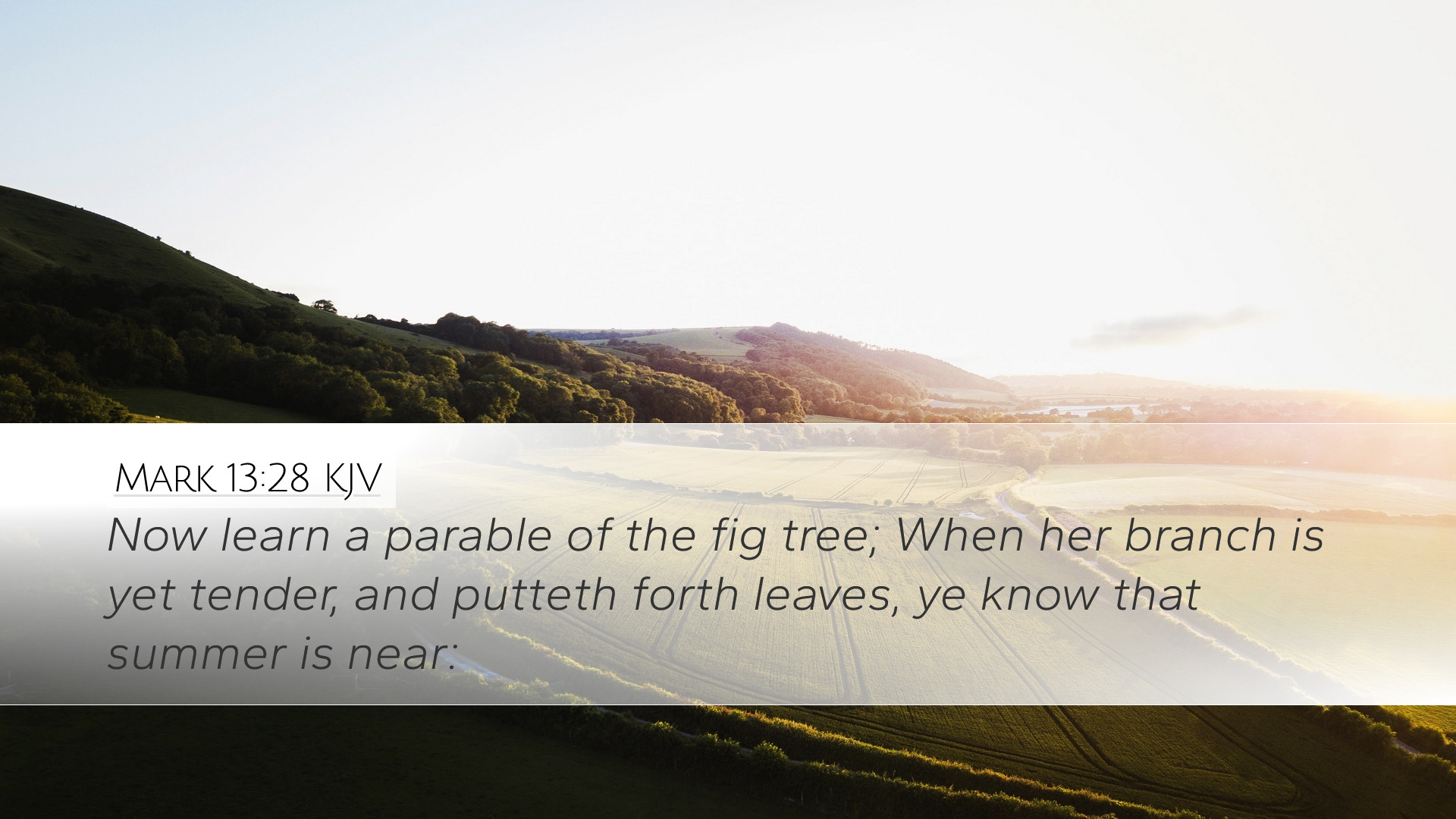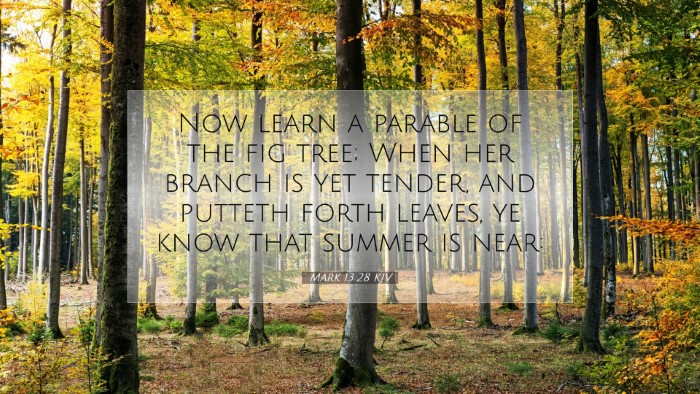Commentary on Mark 13:28
Mark 13:28 states: "Now learn this parable from the fig tree: When its branch has already become tender and puts forth leaves, you know that summer is near." This verse forms part of a significant teaching by Jesus concerning the signs of the times and His second coming. The use of the fig tree as a metaphor is rich in Jewish history and agrarian culture, making it a powerful illustration for His audience.
Contextual Background
In this chapter, Jesus discusses the future signs leading to the destruction of the Temple and His eventual return. The disciples, having asked Him about the end of the age, receive prophetic insights intertwined with parabolic teaching. Understanding the literary and historical context of Mark 13 enhances our comprehension of this verse.
Insights from Public Domain Commentaries
Matthew Henry's Commentary
Matthew Henry emphasizes the importance of parables in conveying profound truths. He explains that the fig tree is a symbol of Israel, suggesting that just as the fig tree exhibits signs of the changing seasons, so too shall the events surrounding Christ's return be evident. Henry notes:
- Observation of Signs: Just as one who knows nature can predict the change of seasons, believers should be vigilant for spiritual signs of Christ's return.
- Spiritual Readiness: The parable serves as an admonition to be prepared. The gentleness of the fig tree's signs urges the faithful to remain watchful and expectant.
- Hope in His Coming: The tender branch signifies hope, much like the believer's anticipation for Christ’s eventual return, which should be met with readiness.
Albert Barnes' Notes
Albert Barnes provides a detailed examination of this verse, focusing on its implications for understanding prophetic fulfilment. He states:
- Specificity of the Analogy: The fig tree's seasonality illustrates that God’s plans unfold with certainty. Just as natural signs indicate seasonal changes, spiritual signs prelude significant divine actions.
- Encouragement to Observe: Barnes urges believers to discern the conditions of their times, drawing parallels to the Jewish people who missed the coming of Christ despite the signs.
- The Assurance of Fulfillment: His commentary highlights the certainty of God’s promises, suggesting that just as summer follows spring, so will the promises of Christ's return materialize in due season.
Adam Clarke's Commentary
Adam Clarke focuses on the specifics of nature and the parabolic teaching of Jesus, noting:
- Fig Tree as a Teaching Tool: Clarke asserts the genius of using accessible imagery such as the fig tree, allowing all to grasp the reality of the Kingdom of God nearing its fruition.
- Lessons on Awareness: He emphasizes the need for spiritual insight and awareness, asserting that the signs of the times are evident to those who are observant and discerning.
- Exhortation to Prepare: Clarke cautions believers not to be complacent or blind to the signs but to ready themselves for the inevitable return of Christ.
Theological Reflections
The theological implications of Mark 13:28 are profound. The fig tree metaphor serves as a reminder of God’s sovereignty over history and His intention to reveal His plans to humanity. This verse invites reflection on several key themes:
- Providence: Recognizing God’s hand in the natural world should encourage believers to trust in His providential care and the unfolding of His divine plan.
- Readiness and Vigilance: Believers are called to remain vigilant, interpreting the signs around them in light of scripture. This readiness is not merely passive but active engagement and preparation for Christ’s return.
- Hope and Assurance: The tender branch signifies hope, assuring the faithful that God's promises remain true and the fulfillment of prophecies is certain.
Practical Applications
For pastors, students, and theologians, the teachings of Mark 13:28 prompt several practical applications:
- Encouraging Spiritual Discernment: Church leaders should teach their congregations to cultivate discernment regarding spiritual and moral conditions, fostering an awareness of God’s signs today.
- Fostering Preparedness: Sermons and teachings should encourage believers to live in a state of preparedness, emphasizing the importance of maintaining a deep, abiding faith.
- Promoting Hopefulness: In times of uncertainty and chaos, the church is called to promote the hope of Christ's return, reminding believers that God’s timing is perfect.
Conclusion
Mark 13:28 serves as a profound reminder of the intersection of nature, prophetic insight, and spiritual readiness. The insights from Matthew Henry, Albert Barnes, and Adam Clarke offer a rich tapestry of understanding that encourages believers to be vigilant and hopeful.
In studying this parable, one finds not only an eschatological message but also a call to live a life of readiness, infused with both hope and a proactive approach to faith. The parable of the fig tree, therefore, remains timeless, applying to a contemporary audience eager for spiritual truth and divine assurance.


